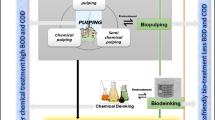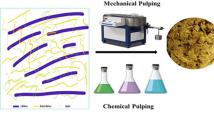Abstract
Microbiological control programmes at industrial level should aim at reducing both the detrimental effects of microorganisms on the process and the environmental impact associated to the use of biocides as microbiological control products. To achieve this target, new efficient and environmentally friendly products are required. In this paper, 17 non-specific, commercial enzymatic mixtures were tested to assess their efficacy for biofilm prevention and control at laboratory and pilot plant scale. Pectin methylesterase, an enzyme found in the formulation of two of the mixtures tested, was identified as an active compound able to reduce biofilm formation by 71% compared to control tests.





Similar content being viewed by others
References
Bajpai P (1999) Application of enzymes in the pulp and paper industry. Biotechnol Prog 15:147–157
Bardouniotis E, Ceri H, Olson ME (2003) Biofilm formation and biocide susceptibility testing of Mycobacterium fortuitum and Mycobacterium marinum. Curr Microbiol 46:28–32
Blanco A (2003) Microbiology in papermaking. Recent Res Devel Appl Microbiol Biotechnol 1:187–134
Blanco A, Negro C, Gaspar I, Tijero J (1996) Slime problems in the paper and board industry. Appl Microbiol Biotechnol 46:203–208
Bott TR (1998) Techniques for reducing the amount of biocide necessary to counteract the effects of biofilm growth in cooling water systems. Appl Ther Engin 18:1059–1066
Burmolle M, Webb JS, Rao D, Hansen LH, Sorensen SJ, Kjelleberg S (2006) Enhanced biofilm formation and increased resistance to antimicrobial agents and bacterial invasion are caused by synergistic interactions in multi-species biofilms. Appl Microbiol Biotechnol 6:3916–3923
Carpentier B, Chassaing D (2004) Interactions in biofilms between Listeria monocytogenes and resident microorganisms from food industry premises. Int J Food Microbiol 97:111–122
Costerton JW (2007) The biofilm primer. Springer-Verlag Berlin, Heiderberg
Femenia A, Garosi P, Roberts K, Waldron KW, Selvendran RR (1998) Tissue-related changes in methyl-esterification of pectic polysaccharides in cauliflower (Brassica oleracea L. var. botrytis) stems. Planta 205:438–444
Jefferson K (2004) What drives bacteria to produce a biofilm? FEMS Microbiol Lett 236:163–173
Jensen A, Larsen M, Ingmer H, Vogel B, Gram L (2007) Sodium chloride enhances adherence and aggregation and strain variation influences invasiveness of Listeria monocytogenes strains. J Food Prot 70:592–599
Johnsrud SC (1997) Biotechnology for solving slime problems in the pulp and paper industry. Adv Biochem Eng Biot 57:311–328
Kielemoes J, Bultinck I, Storms H, Boon N, Verstraete W (2002) Occurrence of manganese-oxidizing microorganisms and manganese deposition during biofilm formation on stainless steel in brackish surface water. FEMS Microbiol Ecol 39:41–55
Kristensen JB, Meyer RL, Laursen BS, Shipovskov S, Besenbacher F, Poulsen CH (2008) Antifouling enzymes and the biochemistry of marine settlement. Biotechnol Adv 26:471–481
Lahtinen T, Kosone M, Tiirola M, Vuento M, Oker-Blom C (2006) Diversity bacteria contaminating paper machines. J Ind Microbiol Biotechnol 33:734–740
Longhi C, Scoarughi GL, Poggiali F, Cellini A, Carpentieri A, Seganti L, Pucci P, Amoresano A, Cocconcelli PS, Artini M, Costerton JW, Selan L (2008) Protease treatment affects both invasion ability and biofilm formation in Listeria monocytogenes. Microb Pathog 45:45–52
Mckay AM (1993) A review microbial carboxylic ester hydrolases (EC 3.1.1) in food biotechnology. Lett Appl Microbiol 16:1–6
Micheli F (2001) Pectin methylesterases: cell wall enzymes with important roles in plant physiology. Trends Plant Sci 6(9):414–419
N. N. Directive 98/8/EC of the European parliament and of the council of 16 February 1998 concerning the placing of biocidal products on the market
REACH Regulation (EC) No 1907/2006 of the European Parliament and of the Council of 18 December 2006 concerning the Registration, Evaluation, Authorisation and Restriction of Chemicals (REACH), establishing a European Chemicals Agency, amending Directive 1999/45/EC and repealing Council Regulation (EEC) No 793/93 and Commission Regulation (EC) No 1488/94 as well as Council Directive 76/769/EEC and Commission Directives 91/155/EEC, 93/67/EEC, 93/105/EC and 2000/21/EC
Orgaz B, Kives J, Pedregosa AM, Monistrol IF, Laborda F, SanJose C (2006) Bacterial biofilm removal using fungal enzymes. Enzyme Microb Technol 40:51–56
Orgaz B, Neufeld RJ, SanJose C (2007) Single-step biofilm removal with delayed release encapsulated Pronase mixed with soluble enzymes. Enzyme Microb Technol 40:1045–1051
Oulahal N, Martial-Gros A, Bonneau M, Blum LJ (2007) Removal of meat biofilms from surfaces by ultrasounds combined with enzymes and/or a chelating agent. Innovative Food Sci Emerg Technol 8:192–196
Pedersen K (1982) Method for studying microbial biopelículas in flowing-water systems. Appl Microbiol Biotechnol 46:6–13
Rättö M, Verhoef R, Suihko ML, Blanco A, Schols HA, Voragen AGJ, Wilting R, Siika-aho M, Buchert J (2006) Colanic acid is an exopolysaccharide common to many enterobacteria isolated from paper-machine slimes. J Ind Microbiol Biotechnol 33:359–367
Schenker AP, Gould IM (1996) Modern microbiological control in closed recycled paper systems. COST Action E1 Conference Improvement of recyclability and the recycling paper industry of the future. Las Palmas 24–26 November 155–162
Simoes M, Simoes L, Vieira M (2010) A review of current and emergent biofilm control strategies. Food Sci Technol 43:573–583
Sutherland I (1999) Polysaccharases for microbial exopolysaccharides. Carbohydr Polym 38:319–328
Sutherland IW (2001) Biofilm exopolysaccharides: a strong and sticky framework. Microbiol 147:3–9
Sutherland IW (2005) Microbial exopolysaccharides. In: Dumitriu S (ed) Polysaccharides, structural diversity and functional versatility. Marcel Dekker, New York, pp 431–457
Suutarinen J, Honkapää K, Heiniö R, Mustranta A, Liukkonen-lilja H, Mokkila M (2002) Modeling of calcium chloride and pectin methylesterase prefreezing treatments of strawberries and jams. J Food Sci 67(3):1240–1248
Torres CE, Gibello A, Nande M, Martin M, Blanco A (2008) Fluorescent in situ hybridization and flow cytometry as tools to evaluate the treatments for the control of slime-forming enterobacteria in paper mills. Appl Microbiol Biotechnol 8:889–897
Van Haute E (1999) Biodispersant and enzyme treatments. A new approach to deposit control. Proc. 53rd Appita Annual Conference, Rotorua, New Zealand 2575–579
Van Houdt R, Michielis C (2005) Role of bacterial cell surface structures in Escherichia coli biofilm formation. Res Microbiol 156:626–633
Verhoef R, Schols HA, Blanco A, Siika-aho M, Rattö M, Buchert J, Lenon G, Voragen AGJ (2005) Sugar composition and FT-IR analysis of exopolysaccharides products by microbial isolates from paper mill slime deposits. Biotechnol Bioeng 91:91–105
Wesenberg D, Kyriakides I, Agathos SN (2003) White-rot fungi and their enzymes for the treatment of industrial dye effluents. Biotechnol Adv 22:161–187
Acknowledgements
The authors wish to express their appreciation to European Union for supporting the Project “Eco-efficient Novel Enzymatic Concepts (GRDI-2000-25676)” and the Community of Madrid for funding the projects PROLIPAPEL I (S-0505/AMB-0100) and PROLIPAPEL II (S-2009/AMB-1480).
Author information
Authors and Affiliations
Corresponding author
Rights and permissions
About this article
Cite this article
Torres, C.E., Lenon, G., Craperi, D. et al. Enzymatic treatment for preventing biofilm formation in the paper industry. Appl Microbiol Biotechnol 92, 95–103 (2011). https://doi.org/10.1007/s00253-011-3305-4
Received:
Revised:
Accepted:
Published:
Issue Date:
DOI: https://doi.org/10.1007/s00253-011-3305-4




